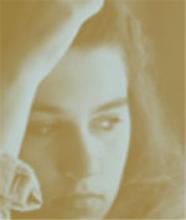Table 2
SSRI DOSAGES FOUND TO BE EFFECTIVE IN ADOLESCENTS WITH MDD
| Drug | Dosage (per day) | Reference |
|---|---|---|
| Fluoxetine | 20 mg | Emslie et al, 1997 and 20018,9 |
| Citalopram | 20-40 mg | Wagner et al, 200110 |
| Paroxetine | 20-40 mg | Keller et al, 200114 |
| Sertraline | 50-200 mg | Donnelly et al, 200115 |
Because of the risks of suicide and social and academic impairment, monitoring alone is acceptable only for a few weeks, and only in cases where depression is mild and uncomplicated. In any case, “monitoring” requires that you periodically reassess the teen and be available for consultation between assessments.
Nonspecific supportive therapy Most psychotherapy provided in the community probably is nonspecific (i.e., not theoretically driven or conducted according to a treatment manual) and supportive (i.e., aimed at providing encouragement). This approach is known to be less effective than specific psychotherapies or antidepressant pharmacotherapy, but we have virtually no data comparing it with lack of treatment.
Nonspecific supportive therapy can be considered a reasonable first-step treatment for depressed teens without complicating risk factors.13 Specific treatment is indicated, however, if the adolescent does not improve in a few weeks.
Pharmacotherapy A few placebo-controlled clinical trials have studied the efficacy of selective serotonin reuptake inhibitors (SSRIs) in outpatient adolescents with major depression. It must be noted that practically all the available data relate to major depression, and no systematic studies have been done in dysthymia and other types of depression in this population.
The SSRIs fluoxetine,8,9 citalopram,10 paroxetine,14 and sertraline15 can decrease symptoms of adolescent depression over 2 to 3 months when given at dosages similar to those used in adults (Table 2). At this time, there are no data that suggest the SSRI dosage must be different in younger (12-year-old) compared with older (18-year-old) adolescents, or in girls compared with boys.
The response rate (adolescents who were substantially improved at end of treatment) ranged from 52 to 65% with SSRI medication and 33 to 48% with a placebo. This means that one would need to treat about six adolescents in order to add one to those who would improve by taking a placebo. Thus, 6 is the number needed to treat (NNT), a common index used to make decisions in evidence-based medicine. As a comparison, the NNT is 1.5 for stimulant treatment of ADHD, indicating that stimulants are more effective in ADHD (i.e., the difference between an active drug and a placebo is greater) than SSRIs are in depression.
It must be noted that receiving a placebo in clinical trials of depression does not equal absence of treatment. Typically, research participants assigned to a placebo have weekly clinical contacts, so placebo treatment could be defined as “nonspecific clinical management.” In any case, the NNT for SSRIs in adolescent depression does not appear to be substantially different from that found in adults.
There is no evidence that tricyclic antidepressants, or TCAs, are more effective than a placebo in adolescents with depression. Considering TCAs’ side effects and potential cardiotoxicity in overdose, their use is not recommended in depressed adolescents. Other antidepressants, such as bupropion and venlafaxine, have been reported to be effective in open studies and clinical observations.
Antidepressants can trigger mania in persons predisposed to bipolar disorder. Before prescribing antidepressant medications, carefully evaluate depressed adolescents for present and past symptoms of mania or hypomania and check family history for possible bipolar disorder. During treatment, monitor the adolescent for signs that suggest emerging mania.
SSRIs and stimulant medications are commonly combined, as depression and ADHD often coexist. Clinical experience indicates that these medications can be safely combined in most cases, although no systematic studies of this combination have been performed in large, representative samples of teens. As with antidepressant monotherapy, adolescent patients must be monitored for signs of mania or hypomania.
Specific psychotherapy Among psychotherapies for depression, the best evidence of efficacy exists for cognitive-behavioral therapy (CBT), which attempts to correct cognitive distortions associated with depression and promotes healthy behaviors. In two clinical studies, CBT was more effective in depressed adolescents than no treatment (i.e., wait list), supportive therapy, or systemic behavior family therapy. About two-thirds of patients treated with CBT achieved remission from depressive symptoms.16,17
Interpersonal therapy (IPT) has been adapted for use in depressed adolescents.18 Its efficacy is supported by one controlled study that found greater improvement after 12 weekly IPT sessions than after once-monthly clinical contact.19 There is no convincing evidence that family therapies are effective in treating depression in adolescents or add much to the benefit of CBT.17
Combined treatment Research on combined treatments for adolescent depression has been limited. One study found that adding family therapy to CBT does not improve the adolescent’s depressive symptoms.8 Although no data are available on the combination of SSRI medication and CBT (or IPT), the National Institute of Mental Health is funding two studies on this important issue:


